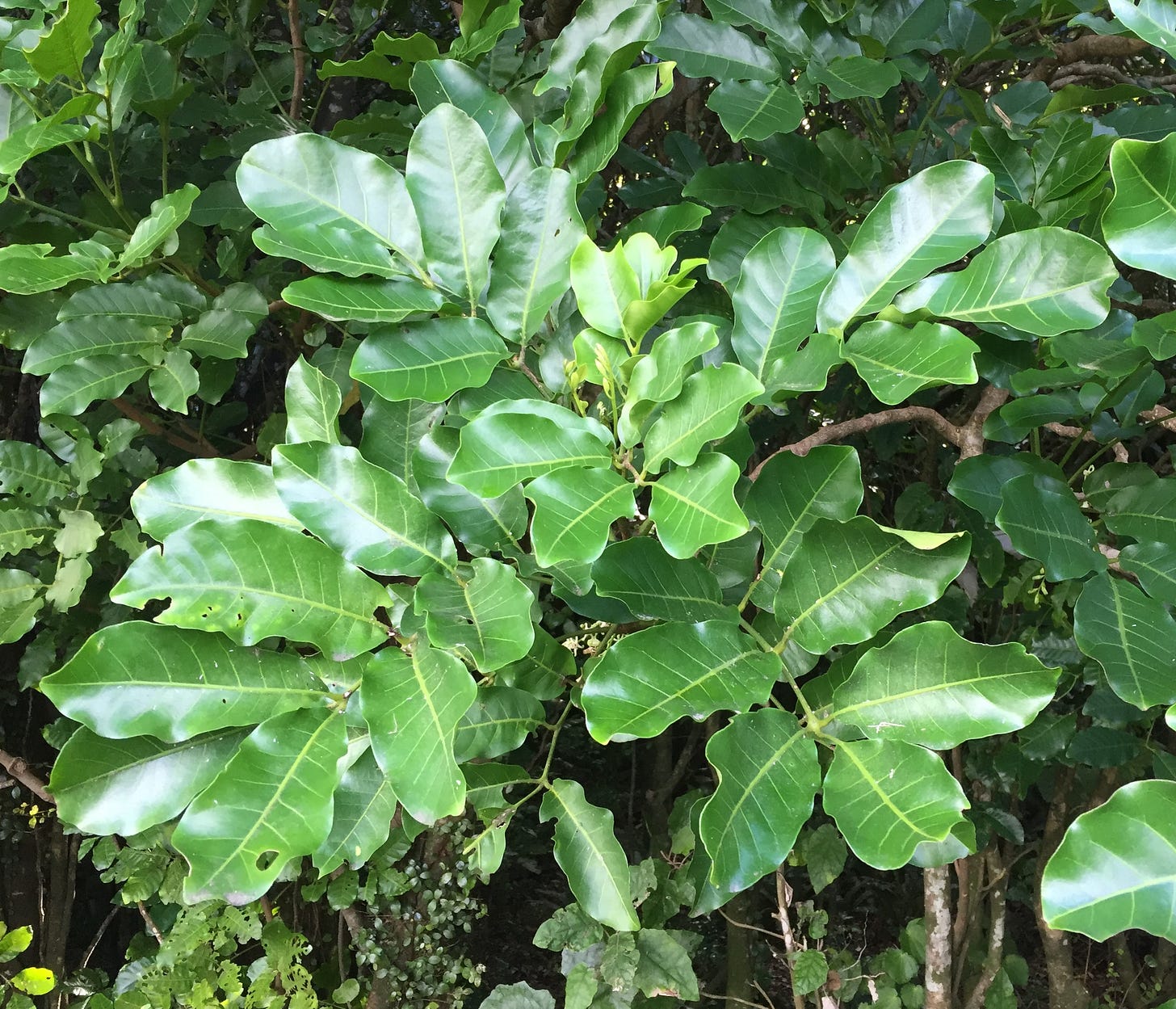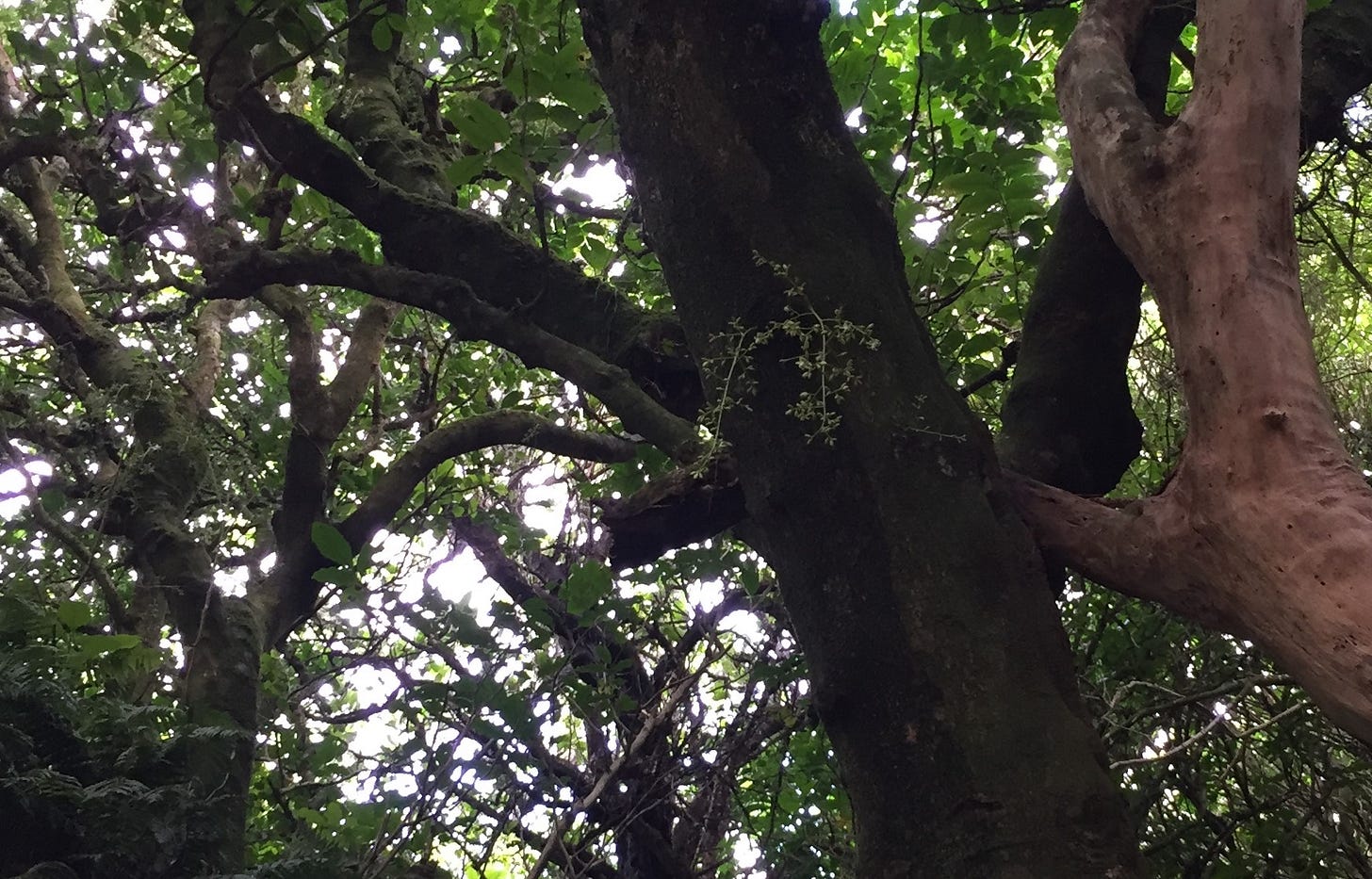On a classic Wellington day, when the rain pours sideways instead of down, there’s no better place to walk than deep in the bush. With gumboots on my feet and head-to-ankle wet weather gear, I put my dog, Donna, on a long leash and walk up and down the tracks of Khandallah park. The smell of damp bush fills my nostrils, and I’m cocooned in dim, green light. Above my head, the flowers of kohekohe trees burst straight from their trunks, a curious way of flowering more typical of trees that grow in tropical rainforest.
I’m walking on the lower slopes of a hill that most Wellingtonians know as Mt. Kaukau. The majority pronounce it cow-cow, but a few give it Māori pronunciation, so it sounds like a chocolatey drink, cocoa. I became curious about the the origin of it, and what it meant, and so I looked it up. It wasn’t easy to find an answer though. Kaukau is a Māori word – it means ‘to swim’ – but that wasn’t how it got the name. The Māori name for Mt Kaukau is Tarikākā, and, as far as I can tell, ‘Kaukau’ is thought to be a careless transcription, similar to the way the locals from Paekākāriki sometimes refer to it as ‘Pie-cock”.
The name Tarikākā is rather more meaningful than Kaukau. It means “where the parrots rested”, more specifically the large bush parrot, the kākā. Once, the forests of Tarikākā must have been alive with the calls of kākā – a series of screeches, cackles and chortles, along with some more melodious notes. The link I’ve given has some recordings of their calls, so have a listen if you aren’t familiar with them. Where kākā are abundant, such as on offshore islands like Little Barrier/ Hauturu, they travel through the bush in large flocks. They were once common throughout New Zealand, but they are rare in most places these days, their populations devastated by habitat loss and predators such as stoats. It’s a familiar, sad story to those concerned about New Zealand’s native species.
The kākā is actually a rare type of rare bird – while it is still regarded as a threatened species, its conservation status is ‘recovering’, which means that its population is actually increasing. And there’s no better place to understand why than the slopes of Tarikākā, where you can once again hear and see these special birds.
The credit for the return of kākā to Wellington, after nearly 100 years of absence, goes to the Zealandia sanctuary. Zealandia was the idea of Jim Lynch, who, in the early 1990s, proposed what was then a rather crazy idea – fence the forested valley that used to be Wellington’s water supply to keep out predators, and create a sanctuary where native species could recover. In 1999 the fence was built and work began to eradicate the predators inside the fenced area. In 2002, a few captive-reared kākā were introduced and the birds thrived in the predator-free sanctuary. The population grew and the kākā, who had no respect for fences, began turning up outside the sanctuary. They turned up in the garden of some friends who lived in Karori, and munched on their walnut tree. They turned up in the botanical gardens. I spotted some in a tree less than 5 minutes walk from my inner-city office. And, eventually, they showed up on Tarikākā.
The kākā aren’t just flying out of the sanctuary occasionally. By mid-2019, more than 1000 kākā had been banded at Zealandia, and unbanded birds were also being found. The unbanded birds were evidence that kākā were breeding outside Zealandia. In fact, kākā have even made attempts to breed in the roof spaces of some Wellington houses. The growing number of Wellington kākā has prompted some people to call their reintroduction a mistake, as they can damage trees and, in some cases, buildings. Kākā in urban areas are also at risk of eating things that they shouldn’t, leading to metabolic disorders and even the risk of lead poisoning. A Massey University study found nearly half of adult kākā tested had lead in their blood, and higher blood lead levels were associated with poorer body condition.
Having a rare bird living right in the middle of our capital city has brought challenges for both the birds and the human residents, without a doubt. But when I hear or see a kākā in Wellington, especially when I’m walking on Tarikākā, my heart sings. I can remember when the sight of a kākā was the privilege of only a few, and the idea that they, and other rare birds, could be seen in the middle of a city would have seemed impossible. We are incredibly lucky to have Zealandia in Wellington.
But the recovery of Tarikākā is not just because of Zealandia. At the start of this article, I mentioned the flowering of the kohekohe trees, and that was quite intentional. The flowering of kohekohe is something that tells me that the bush itself is thriving on Tarikākā, not just the birds.
Kohekohe is a special New Zealand tree. Its botanical name is Dysoxylum spectabile, which means that it belongs to a group of trees that occur mostly in the tropics, part of the mahogany family, and that the botanist who named it, Georg Forster, thought that it was a particularly beautiful example of its group. It looks like a tropical tree too, just the kind of thing that you might see in the north of Queensland or the jungles of Borneo. In many lowland areas of New Zealand, it is an important part of the forest canopy. Unfortunately, though, possums love it, and eat the leaves, flowers and fruit. They can even kill adult trees. Because kohekohe is often a dominant species, if possums aren’t controlled the health of the whole forest can be harmed.
So, when I walk on Tarikākā and see flowers sprouting from kohekohe tree trunks, I know that there must be some intensive possum control going on. In this case, the credit goes to Greater Wellington Regional Council, which has a major possum control programme, protecting Wellington’s forests with traps and poison bait stations. And they’re not just doing possum control. The bush on Tarikākā is designated as part of Wellington’s network of key native ecosystems – areas that the council has prioritised to receive protection. It means that Greater Wellington is controlling a range of pests and weeds there, as well as supporting community groups doing additional pest control.
For many years it was possible to walk through the New Zealand bush and hear nothing much beyond your own footsteps and the occasional fantail or tui. But, with possum and predator control, the birds are back, and so is the birdsong. The forest sounds as it is supposed to – alive.
Now that the forest is thriving and the eponymous kākā have returned, it seems a little sad that Tarikākā is lumbered with a careless mispronunciation for an official name. Calling it Mount Kaukau doesn’t acknowledge anybody’s ancestor, any historical event, or anything interesting at all. Perhaps it is time to restore its identity, and change the official name from Mount Kaukau back to the original, and once again accurate, name of Tarikākā.
Did you receive The Turnstone from a friend? You can subscribe and receive it directly every week.
Do you want to see more of The Turnstone? All of the stories can be found in the archive, here.





